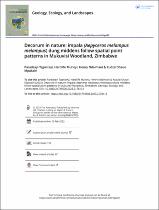| dc.contributor.author | Mpakairi, Kudzai Shaun | |
| dc.contributor.author | Tagwireyi, Paradzayi | |
| dc.contributor.author | Muhoyi, Hardlife | |
| dc.date.accessioned | 2023-04-19T13:20:48Z | |
| dc.date.available | 2023-04-19T13:20:48Z | |
| dc.date.issued | 2023 | |
| dc.identifier.citation | Tagwireyi, P., Muhoyi, H., Ndaimani, H. and Mpakairi, K.S., 2023. Decorum in nature: impala (Aepyceros melampus melampus) dung middens follow spatial point patterns in Mukuvisi Woodland, Zimbabwe. Geology, Ecology, and Landscapes, pp.1-8. | en_US |
| dc.identifier.uri | https://doi.org/10.1080/24749508.2023.2178113 | |
| dc.identifier.uri | http://hdl.handle.net/10566/8836 | |
| dc.description.abstract | Guided by the Optimum Foraging Theory,the Avoidance Concept, and assuming that the impala Aepyceros melampus melampus defecate purposevely at dung middens, we hypothesized that the impala’s dung midden locations do not: (1) follow complete spatial randomness; (2) cluster along park tracks; and (3) cluster along the waterways. Using geolocation data for all impala dung middens in the Mukuvisi Woodland, Zmbabwe, the G(r) function revealed a clustered pattern at 0–100 m. Additionally, the 2nd Order Gcross function showed evidence of spatial aggregation of dung middens to within 25 m of park tracks, but no evidence of spatial aggregation between impala dung middens and waterways. Our findings give insight into possible evolutionary decorum for optimum olfaction, energy-saving, disease,pest avoidance, and contamination avoidance. | en_US |
| dc.language.iso | en | en_US |
| dc.publisher | Geology, Ecology, and Landscapes | en_US |
| dc.subject | G(r) function | en_US |
| dc.subject | Gcross function | en_US |
| dc.subject | Maptools | en_US |
| dc.subject | Complete spatial randomness | en_US |
| dc.subject | Zimbabwe | en_US |
| dc.title | Decorum in nature: impala (Aepyceros melampus melampus) dung middens follow spatial point patterns in Mukuvisi Woodland, Zimbabwe | en_US |
| dc.type | Article | en_US |

